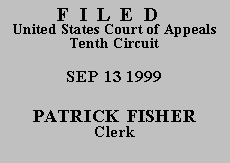

| JAMES L. UPSHUR, JR.,
Petitioner-Appellant,
v.
ROBERT HICKOCK; ATTORNEY
GENERAL OF THE STATE OF
COLORADO Respondents-Appellees. |
No. 99-1156
(D.C. No. 98-D-2437) (Colorado) |
Mr. James L. Upshur, Jr., a pro se prisoner, filed a petition for habeas corpus pursuant to 28 U.S.C. § 2254. The district court dismissed the petition as time-barred under AEDPA and denied Mr. Upshur's motion for a certificate of appealability. He moves this court for a certificate of appealability. We deny his motion and dismiss the appeal.
Mr. Upshur is currently serving a sentence in state prison for racketeering, theft and forgery. He filed his petition for habeas corpus on November 6, 1998, and this proceeding is therefore governed by the provisions of the Antiterrorism and Effective Death Penalty Act of 1996 (AEDPA). See 28 U.S.C. § 2254. That Act establishes a one-year limitation period for filing habeas petitions seeking relief from state court convictions. The limitation period begins to run from the time the judgment of conviction becomes final and is tolled for any period during which an application for state post-conviction relief has been properly filed. See 28 U.S.C. § 2244(d)(2).
In the instant case, Mr. Upshur's conviction on direct appeal was affirmed on January 25, 1996. The Colorado Supreme Court denied his petition for certiorari on September 3, 1996. Under 28 U.S.C. § 2244(d)(1)(A) his conviction became final on December 2, 1996, when the ninety-day period for seeking a writ of certiorari from the United States Supreme Court expired. From that final date, his time began to run until it was tolled on January 28, 1997, when he filed his Rule 35(b) motion for state post conviction relief. The AEDPA time clock was suspended until the Rule 35(b) motion was dismissed without prejudice on October 15, 1997. In a calculation that tolls the time from January 28, 1997 to October 15, 1997, Mr. Upshur's one-year time limitation from the date of final judgment, December 2, 1996, expired on August 19, 1998. He filed his petition for habeas corpus on November 6, 1998, two months after this deadline. On appeal, Mr. Upshur asserts that time limitations ought not to apply to constitutional claims that are meritorious. Congress has decided otherwise. Because the AEDPA statute explicitly bars untimely habeas corpus claims such as this one, Mr. Upshur may not file an action past the deadline no matter how meritorious he believes his claims to be.
Mr. Upshur has not "made a substantial showing of the denial of a constitutional right" as required for the issuance of a certificate of appealability. 28 U.S.C. S 2253(c)(2). Accordingly, we DENY his motion for a certificate and DISMISS the appeal.
ENTERED FOR THE COURT
Stephanie K. Seymour
Chief Judge
*.This order and judgment is not binding precedent, except under the doctrines of law of the case, res judicata, or collateral estoppel. The court generally disfavors the citation of orders and judgments; nevertheless, an order and judgment may be cited under the terms and conditions of 10th Cir. R. 36.3.